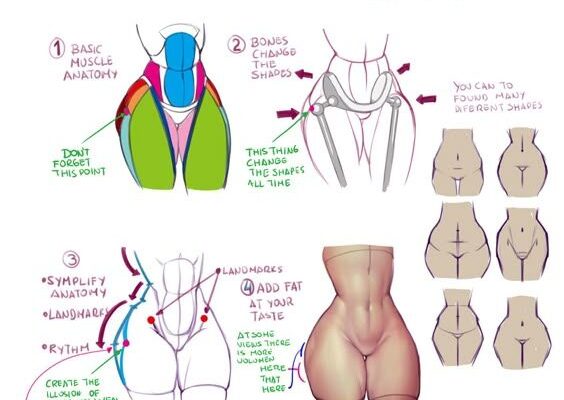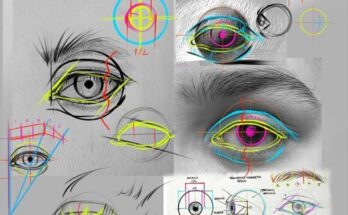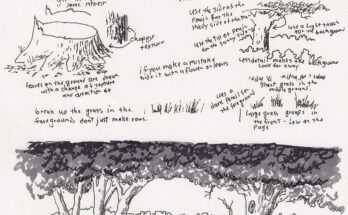Step-by-Step Guide to Drawing a Stylized Fantasy Warrior in Dynamic Pose: Anatomy, Armor, and Weapon Detailing for Concept Art
Creating a compelling fantasy warrior is a cornerstone skill for artists venturing into concept art, gaming, or fantasy illustration, blending anatomical accuracy with imaginative design. This detailed tutorial is inspired by a reference sketch titled “Warrior,” which depicts a stylized male figure in a dynamic, forward-leaning pose, mid-combat, wielding a double-headed axe. The image, rendered in pencil with clean lines and light shading, features a muscular build accentuated by detailed armor—shoulder plates, chest guard, and greaves—along with flowing hair and a tattered cape. Red construction lines overlay the figure to highlight gesture, joint placement, and perspective, guiding the viewer through the pose’s energy and balance. Annotations emphasize key areas like the torso twist, weight distribution, and weapon grip, making it an ideal blueprint for artists aiming to infuse action and personality into their characters.
This guide is designed for intermediate artists, whether working traditionally with graphite on bristol paper or digitally using tools like Photoshop, Procreate, or Krita, where layers can separate guidelines from final renders. We’ll break it down into sections based on the reference: establishing the gesture and pose, building the anatomy and armor, detailing the weapon and accessories, and adding finishing touches. Key techniques include using gesture lines for flow, applying foreshortening for depth, and layering textures for armor realism. This approach suits fantasy genres like Dungeons & Dragons illustrations or video game character designs, encouraging reference from dynamic poses (e.g., action photography) or anatomical studies. Start with light sketching tools (e.g., H pencil or 20% opacity brush), a ruler for perspective, and an eraser for adjustments, progressing to B pencils or opacity builds for shading. Given today’s date—04:03 AM EDT on Wednesday, October 22, 2025—consider a dawn battle scene to align with the early morning vibe.
Section 1: Establishing the Gesture and Pose (Red Construction Lines)
The reference’s red lines form the pose’s backbone, capturing the warrior’s forward momentum and combat readiness.
- Mapping the Gesture Line: Begin with a sweeping red line from the head, curving through the spine, and extending to the lead foot (right leg forward). The image shows a pronounced S-curve: the torso twists left as the right shoulder lunges forward, creating tension. Draw this as a single, fluid stroke, about 7-8 head heights tall, to establish the figure’s energy.
- Marking Joints and Axes: Place red circles at key joints—shoulders, elbows, hips, knees, and ankles—adjusting sizes for prominence (e.g., larger at hips for weight). Add axes along limbs: the right arm bends at a 45-degree angle toward the axe, the left arm pulls back, and legs stagger with the left knee bent. The reference’s low perspective enhances the warrior’s dominance, so tilt the horizon upward.
- Perspective and Balance: Use a two-point perspective with vanishing points off-canvas to the left and right, converging lines toward the chest and feet. Ensure weight shifts to the right leg, with the left leg trailing for stability. Tip: Pose in a mirror to feel the stretch. Common error: Stiff limbs—keep lines organic. Exercise: Sketch 3 quick gestures of this pose (neutral, exaggerated, reversed) using only red lines to build fluidity.
This step locks in the action, preventing static or unbalanced figures.
Section 2: Building the Anatomy and Armor (Base Structure)
The reference’s pencil lines define a muscular frame, enhanced by stylized armor that follows the body’s contours.
- Anatomical Base: Sketch the torso as a tapered cylinder, wider at the shoulders (about 2.5 head widths) and narrowing at the waist. Add pectorals as rounded planes, abs as segmented curves, and thighs as thick ovals. The image’s forward lean foreshortens the chest, so compress the far side slightly. Proportions: Head to chest (2 units), chest to hips (1.5 units), hips to feet (3.5 units).
- Armor Detailing: Draw shoulder plates as curved triangles overlapping the deltoids, chest guard as a segmented plate with rivets along edges, and greaves as shin guards with strap details. The reference shows armor hugging muscles—e.g., chest plate curves over pecs—indicating a fitted, battle-worn design. Use light hatching for metal texture, denser at joints.
- Pose Integration: Adjust armor for the twist—shoulder plates tilt with the right arm’s motion, greaves flex with the leg bend. Avoid mistake: Overlapping armor—ensure gaps for mobility. Tip: Study plate armor references (e.g., 15th-century knight suits) for rivet patterns. Exercise: Draw the torso and arms with armor, applying the gesture line to check alignment.
This builds a solid, armored form, balancing realism with fantasy flair.
Section 3: Detailing the Weapon and Accessories (Axe and Cape)
The double-headed axe and tattered cape add narrative and visual interest, as highlighted in the reference.
- Axe Construction: Sketch the axe handle as a thick, slightly tapered cylinder extending from the right hand, with double blades as symmetrical, curved triangles at the top. The image shows the near blade larger due to foreshortening, with nicks for wear. Add a grip texture with cross-lines and a metal cap at the base.
- Cape Dynamics: Draw the cape flowing from the left shoulder, rippling backward with the pose’s momentum. Use wavy lines to suggest tattered edges, with folds concentrating at the shoulder and lower hem. The reference’s light shading indicates wind resistance.
- Hand and Grip Details: Refine the right hand with fingers wrapped around the handle, thumb pressing for leverage. The left hand, relaxed, shows open palm lines. Add a wrist guard or bracer for detail.
- Application Notes: Align the axe with the arm axis for natural hold. Common pitfall: Flat cape—add depth with overlapping folds. Exercise: Sketch the axe alone from multiple angles, then integrate with the hand pose.
These elements enhance the warrior’s combat-ready persona.
Section 4: Adding Shading, Textures, and Final Touches
The reference’s shading and details bring the figure to life, suggesting a dawn battle scene.
- Shading for Depth: Apply gradients on a Multiply layer—darkest under armor edges (e.g., armpit, thigh folds) and lightest on protrusions (shoulder plates, axe blade). Use the top-left light source implied in the image, casting shadows downward-right.
- Texture Refinement: Add scratches on armor with short, irregular lines, and hair strands with quick strokes. The cape gets a rougher texture at tears.
- Atmospheric Effects: Given the 04:03 AM EDT time on October 22, 2025, suggest a pre-dawn glow—light purple or blue wash on the background, with mist softening distant elements. Add faint birds or sparks for drama.
- Final Adjustments: Erase stray guidelines, sign in a subtle corner (e.g., lower-left), and critique by flipping horizontally for symmetry.
Additional Professional Tips for Mastery
- Tools and Materials: 2H for guidelines, 4B for shading; digitally, use custom metal brushes. Reference armor photos or 3D models.
- Common Challenges: Foreshortening errors—use a perspective grid. For dynamics, study action poses or slow-motion clips.
- Exercises and Resources: Daily: 15-minute gesture sketches of warriors. Explore “Figure Drawing for All It’s Worth” by Andrew Loomis or online anatomy tools.
- Extensions: Add a background (battlefield, castle), vary weapons (sword, mace), or include a companion figure.
This tutorial harnesses the reference’s energy, guiding you to craft a striking fantasy warrior. Practice regularly, and dive into our related guides for armor variations or epic scenes!




